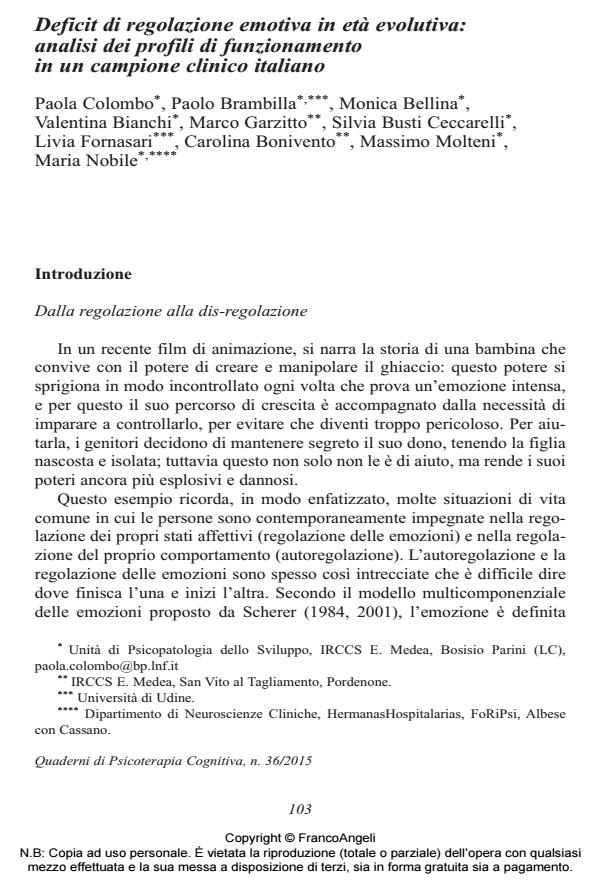Deficit di regolazione emotiva in età evolutiva: analisi dei profili di funzionamento in un campione clinico italiano
Titolo Rivista QUADERNI DI PSICOTERAPIA COGNITIVA
Autori/Curatori Paola Colombo, Paolo Brambilla, Monica Bellina, Valentina Bianchi, Marco Garzitto, Ceccarelli Silvia Busti, Livia Fornasari, Carolina Bonivento, Massimo Molteni, Maria Nobile
Anno di pubblicazione 2015 Fascicolo 2015/36
Lingua Italiano Numero pagine 13 P. 103-115 Dimensione file 139 KB
DOI 10.3280/QPC2015-036008
Il DOI è il codice a barre della proprietà intellettuale: per saperne di più
clicca qui
Qui sotto puoi vedere in anteprima la prima pagina di questo articolo.
Se questo articolo ti interessa, lo puoi acquistare (e scaricare in formato pdf) seguendo le facili indicazioni per acquistare il download credit. Acquista Download Credits per scaricare questo Articolo in formato PDF

FrancoAngeli è membro della Publishers International Linking Association, Inc (PILA)associazione indipendente e non profit per facilitare (attraverso i servizi tecnologici implementati da CrossRef.org) l’accesso degli studiosi ai contenuti digitali nelle pubblicazioni professionali e scientifiche
Il processo di autoregolazione emotiva riveste un ambito d’interesse nello studio della psicopatologia, in particolare in eta evolutiva in quanto un deficit di auto-regolazione puo essere implicato sia in disturbi internalizzanti sia esternalizzanti. Alcuni ricercatori hanno operazionalizzato questo costrutto clinico utilizzando tre scale della CBCL -Child Behavior Check List per misurarlo: ansia/depressione, attenzione, comportamento aggressivo. Tali scale sono state utilizzate anche per identificare livelli piu severi di disregolazione emotiva che definiscono il Dysregulation Profile. Possibili outcome clinici sono stati individuati in difficolta nella regolazione dell’umore, nella gestione dei pensieri/preoccupazioni, nella regolazione del comportamento, nella regolazione cognitiva. In considerazione di queste premesse, il presente lavoro si pone l’obiettivo di studiare, in un campione clinico italiano di 1.224 soggetti in eta evolutiva, i livelli di disregolazione emotiva (CBCL-DESR e CBCL-DP) in funzione delle categorie di inquadramento diagnostico secondo DSM-IV. I risultati di questo studio esplorativo mostrano la presenza di pattern di disregolazione in un’ampia parte del campione clinico in esame, e di grave disregolazione soprattutto nei soggetti con quadro clinico piu grave.
Parole chiave:Disregolazione emotiva e comportamentale, Child Behavior Check List, psicopatologia dello sviluppo.
- Alexithymia and Psychopathological Manifestations Centered on the Body: Somatization and Self-Harm Michela Gatta, Caterina Angelico, Francesca Rigoni, Alessia Raffagnato, Marina Miscioscia, in Journal of Clinical Medicine /2022 pp.2220
DOI: 10.3390/jcm11082220
Paola Colombo, Paolo Brambilla, Monica Bellina, Valentina Bianchi, Marco Garzitto, Ceccarelli Silvia Busti, Livia Fornasari, Carolina Bonivento, Massimo Molteni, Maria Nobile, Deficit di regolazione emotiva in età evolutiva: analisi dei profili di funzionamento in un campione clinico italiano in "QUADERNI DI PSICOTERAPIA COGNITIVA" 36/2015, pp 103-115, DOI: 10.3280/QPC2015-036008